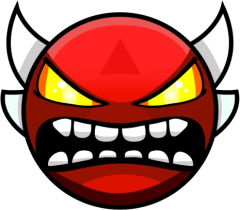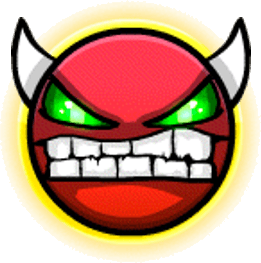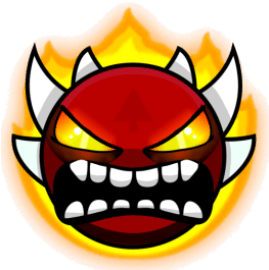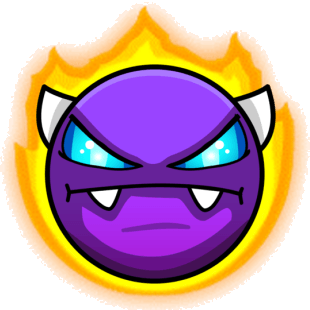Moderator
Rating Curve
Filters
Reviews
QuazeryIceCube's structuring never fails to impress. I absolutely love repetition in small gameplay structures or motifs synced with corresponding repeating elements of the song, and that is everywhere in Spacious Senses. There's so many little sections that repeat 3-5 times in time with the song's echoing synths or drum loops, I really appreciate the consistency and attention to detail in this regard - it's damn impressive that every single noise in this song comes through in one way or another.
I also love the use of default blocks to create art designs, like the flowers and stars near the beginning. In a period dominated by more realistic art that leans towards breaking the bounds of what GD is, these little additions are small, and don't really impact the level's theming or vibes much, but are something I personally appreciate. This applies in a much more impactful manner to the massive geometric shapes created by the blocks and orbs from around 1:40 onwards, with the gameplay forming circles, pillars, tunnels and other shapes. The open gameplay, geometric designs and repeating gameplay all combine to create one of the most visually striking parts I've seen this year.
On top of all this, I found Spacious Senses to be quite a fun experience; heavily reliant on memory, but without any notable choke points and very consistent. I can't recommend enough that you should play this level if you enjoyed any of Quazery's earlier works; it is not only one of my favourites from them, but one that is very characteristically an evolution of their style. Great work!
Sparks Cry of Mercy does a really nice job carrying its song's energy, and has a more raw, unrefined edge that I think works very well with the very messy song that's used. A lot of the block designs are semi-transparent, which historically tends to mean muddy details and a lack of "solidness" to the structures, but two choices were made that I think help the designs out drastically; the consistent use of black "outline" sections, and the general bright colours and subtle details used in the semi-transparent sections. The darker outline portions contrast very nicely with the rest of the level and helps the structures stand out, and the usage of glow and the line-based designs help both break up the large chunks of flat black as well as to add more texture and detail to the designs. The interior semi-transparent portions themselves all have some sort of subtle detailing, similar to reflections bouncing off of glass, and are coloured brightly enough that they aren't muddied too much by the rest of the level and serve to accent it instead.
I also think the less polished nature of the level works in its favour in regards to the gameplay. The structures are all very simple, and there tends to be a lot of negative space between them (most noticeable around 0:49) that relies on the background as filler, but Sparks Cry of Mercy has such fast-paced gameplay and bright colours that I think attempting to remedy these issues would have drastically lowered the gameplay clarity. The simple shapes and excess of negative space combined with the aforementioned contrasting block designs all help the player easily intuit exactly where the gameplay is and what will and will not kill them, which in my opinion is a necessity for fast, high-CPS gameplay and contributes to an overall excellent playing experience for this level. The lack of heavy shaders or camera controls further solidifies the level's already good readability, which is a nice bonus.
Some individual parts do make an effort to stand out - there's a fake 3-way "dual" at 0:51, a dash orb that breaks through one of the structures at 1:13, and some other nice novelties that are very cool additions in their own right - but overall I think the level does get monotonous. The colour scheme stays the same aside from the red in the first part, the structuring and design styles are the same, even the background structures are reused fairly consistently. While cohesive, I'd love to have seen some more usage of slopes, or another spin on the outline sections of the structures, or even a different mechanical/electronic style altogether for some of the more intense parts. However, I'd consider this a relatively minor issue, and overall really enjoy Sparks Cry of Mercy. I will be keeping an eye on ISGAgaru's levels going forward and look forward to more from them.
The Michael gauntlet contest as produced some of the coolest song-focused levels I've ever seen, due to the chaotic, glitchy IDM songs Flash puts out. destination 0 is my personal favourite MGC entry due to how unafraid it is to use repetition to its advantage. The solid bassline comes through in the heart-stamped pillars underneath the player, and both stay constant through the entire level aside from some flashing and wavering, which itself is a great piece of song representation for a prominent element of the song. The energy provided by the glitching, jumpy clicks and synths that make up the lead melodies comes through in a multitude of effects; flashing slopes and outlines for the muted ones, full screen rotating cascading lines for the huge synth pulses, big tapestry-like designs for the building background noise, etc, etc. There's a lot of minute details to both the song and the level that can only really be experienced while playing the level, but my favourite of them all is how the backgrounds colours shift around 2:55 onwards, with the reds and pinks used for more distorted, crunchy synths and blues, purples and teals used for the smoother noises. It's a genuinely fantastic visual representation of a very chaotic melody with a lot of different moving parts, and its simplicity in choosing the colours for each sound is really quite commendable.
Admittedly, destination 0's 4 minute runtime is a bit of a drag, and the slope-focused gameplay can be quite inconsistent due to some fairly difficult timings and general slope jank. However, these are relatively minor issues for me overall, and I'd recommend this level for Epic or Legendary due to just how good it is at representing its song. I hope to see this place highly in the Michael gauntlet contest, and if it doesn't then I'm even more excited to see what's in store for the results. Well done!
I love how much energy is crammed into this level. The designs are pretty unrefined, consisting of a lot of default 2.0 metal and animated blocks that tend to clash pretty hard with the candy-like environments and the very bright rainbow colours chosen, but the level puts its focus on general movement and energy enough that it doesn't really matter. The gameplay is consistently fast-paced and high-intensity, and the choice to use duals at the peaks helps a lot in this regard too. I appreciate the choice to not include too many strict timings, as it lets the player focus more on building a click pattern and enjoying the flow of the level based on muscle memory, which is great for this sort of high-intensity gameplay (as long as it's not strictly click synced - Mint Candy's gameplay is synced more with its movement than clicks, with the icon moving more in line with the pitch and intensity of the synths, which for me is a much more fluid and consistent form of sync for intense gameplay). Everything is balanced quite well, with no noticeable choke points and a good balance of gamemodes depending on what the song calls for - ship for long notes, wave for arpeggiated sections, etc. I really appreciate how much this level feels like it's designed for the player. It's a super enjoyable experience all around, despite looking a little rough, and one of the most fun insane demons I've ever beaten. I'd recommend this for Epic if it wasn't already
We love a good puzzle level. Honestly, I cannot for the life of me figure out how to solve this, so I can't comment much on the actual puzzle design, but aesthetically this ticks just about every imaginable box. Using an alien language for the codes is a good way to add more mystery to the puzzles, and combined with the vaguely industrial backgrounds and the low-quality CRT-like display the player has access to does a good job at making PAIN CONTROL BUS feel like you're tasked to solve an impossible puzzle in an alien civilization. I like this, as it adds more mystery and provides a pretty unique setting for the level.
The emphasis on the impossible part is important - it adds another layer of stress and panic as you're forced to solely rely on memory and pattern recognition rather than any linguistic skills. This is accentuated by the ticking timer and the slow, burning build of both the song's intensity and the progressive breaking down of the level as the colours shift from blue to red and the screen distorts. All of this makes PAIN CONTROL BUS a really enthralling experience (despite my absolute inability to actually solve it), and one of the most stressful levels I've ever played despite the lack of any traditional gameplay. The payoff at the end is really nice, too, as the colours fade to white and the level slowly fades away as if expressing its own sense of relief at being solved and averting whatever consequence might have followed failure. I would recommend this level for Legendary, and think all other puzzle-type levels should take notes on what I previously mentioned makes this such an effective experience.
I really want to touch on the beginning's dual gameplay where the other icon asks to race the player to the moon. This is some of the best thematic setup I've ever seen in a level, and establishes a clear motive and overall trajectory for the level in a way that is both natural (due to the part being dual) and silly. Visually, Dyad is overall quite a silly feeling level, as the decoration style leans heavily into abstraction in most parts. The crunchy, pixelated textures on the "ground" objects in both the earth and moon sections establish a lean away from realism to the player immediately, and plenty of other elements like the shooting stars in the space sections and the giant spinning rainbows in the sky section move or appear in absurd ways that make the player's journey feel more like fantasy, which is nice considering the "race to the moon" theme is quite an unrealistic one outside of a fantasy setting. (edited)
I absolutely love how unafraid Awesomeme360 is to use repetition in this level for song representation (mainly concerning gameplay, but occasionally visuals too). The song uses quite a repetitive drum line and a simple vocal chop that loops and only really changes in time with the level's major visual changes from part to part. The cube gameplay in the beginning section with the groups of three "staircase" blocks serve to represent this repetition, and often they make up 10-15 sections of the level with nothing but that structure repeated when the song calls for it, however orbs and pads are frequently used to create unique gameplay on top of those repeating structures in time with any one-off effects or noteworthy elements of the song. This is not only fantastic for song representation in all regards, but helps keep the player engaged by breaking up the monotony that comes with repeated gameplay.
Lastly, Dyad is great at making the player feel small. Aside from just the overall huge verticality of the level, some set-piece elements in each part are huge and take up multiple screens' worth of space, which helps to reinforce the size of the environment to the player. My favourite example of this is the cloud ring in the UFO section, as it still feels natural and connected with the part because of the general heavy use of clouds in that section, despite the absurdity of a giant ring of clouds appearing in front of the player. Dyad is a fantastic, surprisingly concise and very silly experience, and one with genuine replayability due to the complexity of its world. I would recommend this for Legendary and look forward to more from Awesomeme360.
I've always felt QuazeryIceCube has a fantastic eye for capturing a song's essence really well in their levels, and frozen refraction is no different. The song's minor key and somewhat dissonant synth leads create a colder, more desolate atmosphere, and this translates through the blue/purple colour scheme and very open structuring style of the level that lets the backgrounds shine. I really like how the dash orbs are used in the first drop; the synth wavering comes through in the slopes that redirect the player around, and when the pitch of the synth changes, the player moves around with it. A really cool touch is that cube portals are used for the more subtle pitch shifts during this section, which is a really smart way to stick to the concept while also adding some more variation.
The same ideas are present in the second chorus, but this time the song is far more layered, with way more overlapping synths and instruments. The glowy bar locked to the player splits into two during this second chorus, yet remains audibly and visually very well connected - the split visuals create very bright spots when they overlap, which are generally in time with the most intense sections of the song, and both halves are locked to either the player or the gravity portals. When both parts are combined with this flowing, flashing background of cubes that Quazery uses, it creates such a unique, cold yet lively atmosphere that I've almost never seen done to this level before.
Aside from this, Quazery also represents change in audio exceedingly well. During the buildup to the second drop, the song's intensity slowly increases as the volume of the background synths increases, and this translates via a glowing aura around the player that slowly brightens. The part stays the same throughout, which is an approach I like because only one element of the song is actually changing, and thus only one element of the level changes (significantly). In the first part, as the song starts to pick up, rainbow objects and bright particles are slowly incorporated in time with the bright synth pulses that are introduced, giving the trippy foreground/background masking effect in the part some much needed variation visually. Overall, frozen refraction is a fantastic example of how I like to see song representation approached, and one I would send for Epic. I would encourage many creators to try their hand at incorporating these ideas into their own levels, as I'd love to see how it affects them.
Orchid Sprite is an exemplary project in showing how to stick to and expand upon a base concept through the length of a level. The blooming flowers at the beginning are used and referenced throughout the level, and the theming is consistent and forefront with every single part having its focus placed on either a flower effect, or elements of flowers and insects in the block designs and backgrounds. The bright pink and gold hues used accentuate this as the details usually have colouring that stands out from the base tone of the part (namely, the dual at 1:21 where the flowers have a very distinct colour scheme not used elsewhere in the part), which keeps the overall contrast between foreground and background effects high and highlights each part's unique setpiece. Additionally, many parts of the level use the rule of threes to guide the eye, where detail is focused towards sections that separate the level into thirds either horizontally or vertically, creating a natural path for the viewer's attention to follow. My favourite example of this is the large flowers in the part at 0:20, as they're unobtrusive but serve well to guide the eye and fill some of the larger sections of negative space.
The gameplay is also clean and exceedingly well put together, with a lot of emphasis placed on movement sync. Most parts have a specific movement tied to a major element of the song, like the dash orbs near the beginning and the toggle orbs in the last dual, which is a nice way to help connect all of the level's elements together and better represent the intricate synths of the song. With that said, I wish this was taken to a higher level, for example matching the icon's height or the brightness of certain details to the pitch or volume of the song, as this is an element I feel is oddly missing considering how much care is placed on the aforementioned elements. I also wish the level had more clear-cut visual progression, because as it is the parts feel like they could appear in any order and not change the overall tone or impact of the level significantly due to them sharing very similar colour schemes, levels of energy and detail. However, Orchid Sprite is still a fantastic level and my personal favourite from ImMaxX1. I would recommend this for Legendary and am highly excited for their future projects.
It's been quite a long time since I've seen a level so successfully delve into absurdity in the same way creators like ValentInsanity and BobRatchet did years back. One of the key features that defines these types of levels in my eyes is that everything feels alive; so many of the elements are in constant motion or transition that it makes the player feel like just one part of the environment. The second and third parts highlight this really well, with the bouncing pillars with faces, oscillating ground blocks and the flying drone-like creatures all adding to the feeling that the level is buzzing with life and activity. Every part is completely different, but this base concept as well as some elements of the designs (mainly the use of metallic colours, area triggers for shine and boxy, grid-like designs) are kept consistent throughout, which gives the level a really nice sense of cohesion and helps create this expansive world that the player can get invested into.
A big part of this level I have not yet touched on is the pixellation effect. The shader is quite subtle but in effect for the entire level, and I think this works in the level's favour quite well by making it feel like either a low-quality recording reminiscent of YouTube videos many years back, or like it's a title for an older console being played on an outdated screen. For me, this invokes a strong feeling of nostalgia when combined with the similarity to the aforementioned creators from late 2.0 and early 2.1, but even disregarding this it creates a sensation of being a product of a bygone era that I almost never see in levels and one that gives Degenerate a really unique selling point that makes it quite memorable. I only wish that more care was put into most of the level's backgrounds, as said older creators used many elements of their levels' designs and characters in the backgrounds themselves to add more depth to each individual part, which I love since it helps sell the levels' worldbuilding even more to the player.
I really can't recommend giving Degenerate a watch or play enough, especially to those who are familiar with the era of creators I mentioned above. It's one of the most captivating levels I've seen in quite a while, and I do really have to commend Jorbettt for managing to do something that I've seen so few do in the last few years in evoking that sense of nostalgia and life within its world. I'd recommend this level for Legendary and I'm truly excited to see what else this creator makes going forward. Well done.
LAKE ZURICH was the first level of cometface's I ever saw, way back around December 2021, and it's quite incredible to see how far their style has developed since. This level's designs are very rough around the edges, with many cases of large structures with minimal detail or too much negative space (namely the platforms starting from 1:35). The structuring is generally ok, but is quite basic and doesn't really work with the complexity of the shapes many of them take; they tend to end up feeling somewhat incomplete due to the interior details not fitting in very well with the shape of the structure, as well as the lack of interior details in general, and the first part's large ground structures are the best example of this. I would also have greatly appreciated more variation in colour, as LAKE ZURICH mostly sticks to a single, dark shade of blue right up until the final part. Considering how much depth the song's production has, and how much it changes throughout the length of the level, some hue-shifted pulses or complementary highlights to match the vocals or droning synths would have been nice.
With that said, pretty much everything else about this level is excellent, albeit unpolished. The theming is fantastic, and the slow transition from indoor to outdoor elements throughout the length of the level is subtle but executed very nicely. This also lines up with the way the song slowly adds in more and more "light" sounding elements like the synth plucks and guitar notes. The first part having the night sky only visible through the "windows" creates a very nice sense of depth and helps sell the player being in an indoor environment, making the payoff when everything opens up into an expansive nighttime landscape at 1:12 very rewarding. The final part has very nice structuring, with the constellations making for generally quite unique shapes while still having solid thematic and visual synergy with the rest of the part since it is set in space. The floating glow bars reminiscent of the Aurora Borealis help to further this, and they also help fill in some of the excess negative space left between structures.
LAKE ZURICH is a very solid foundation for what would eventually become the "neodesign" style cometface helped spearhead, and it still holds up very well today, almost 4 years later. It has excellent theming, but lacks a lot of polish and execution in terms of its more traditional design and structuring elements that cometface has slowly iterated and improved upon over the last few years.
GDPR Cookie Consent
Hyperbolus uses cookies and local browser storage to enable basic functionality of the site. If we make any changes to these options we will ask for your consent again.
sorry about this gang







